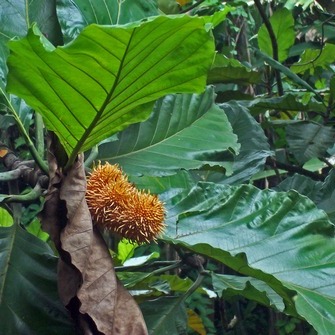Tree up to 45(-65) m tall, evergreen (or deciduous?), with buttresses. Leafy twigs (5-)7-20 mm thick, brown to whitish appressedly puberulous to subhispidulous or to hirtellous or hirsute, sometimes only on the scars of the stipules, ± scabrous or smooth, drying dark brown to blackish; lenticels in the upper part of the internode; scars of the stipules prominent. Leaves spirally arranged; lamina coriaceous to chartaceous, entire, elliptic 13-40(-60) by 6-20(-35) cm, or when juvenile pinnately incised with 3 or 4 (or 5) pairs of lobes, apex short-acuminate, base rounded to cuneate (to subattenuate), margin entire to repand to lobate (or denticulate towards the apex); upper surface minutely whitish puberulous to (sub)hispidulous, on the main veins to hirtellous, ± scabrous or smooth; lower surface brownish to whitish appressedly puberulous or partly strigillose to (sub)hirtellous on the veins, scabridulous or smooth; lateral veins 10-16 pairs, most of them branched or forked away from the margin, tertiary venation scalariform, prominent; areoles usually bullate; petiole 2.5-10 cm long, 2-6 mm thick, brown appressedly puberulous, the epidermis persistent; stipules fully amplexicaul, 4-20 cm long, brown (sub)hirsute to subvillous or to subsericeous, caducous. Staminate inflorescences axillary, solitary; peduncle 3.5-7.5 or 9.5-18 cm long, brown appressedly puberulous; head cylindrical, 6-15 by 1-2.5 cm, sulcate, the grooves often interrupted and almost straight; perianth tubular c. 0.6 mm long, the apex 2-lobed, minutely puberulous; stamen c. 0.9 mm long, anther 0.2-0.4 mm long; interfloral bracts absent. Pistillate inflorescences axillary, solitary; peduncle 4.5-12 cm long, brown appressedly puberulous; head ellipsoid to cylindrical; perianth tubular, brownish (to whitish) puberulous to hispidulous, the apex convex to flat; stigma bifid (with equally or unequally long arms); the flowers intermixed with subulate to filiform (± recurved) 6-12 mm long processes, these brown hispidulous or absent. Infructescences ellipsoid to cylindrical (or to subglobose), (6-)8-12(-17) by 5.5(-10) cm, covered with 1-4 mm long cushion shaped to pyramidate to cylindrical apices of the perianths, intermixed with elongate processes or not; fruits ellipsoid, 0.8-1 cm long.
More
A large tree. It grows to 45 m high. The trunk can be 210 cm across. There are buttresses 3 m high. The bark is grey-brown and slightly scaly. The twigs are 8-20 mm thick. They have dense golden hairs. There are ring like scars. The leaves are alternate and crowded. They are stiffly leathery. They have a blunt form at both ends and are entire or lobed towards the tip. Leaves are 12.5-60 cm long by 10-35 cm wide. There are 12-14 pairs of secondary veins. The male flower parts are yellowish and finger like. They are 6-20 cm long by 2.5-3.8 cm wide. They are grooved. The flower stalk is 40-75 mm long. Female flowers are in rounded heads. The fruit are heavy. They are yellow-brown. They are 11.5 cm long by 5.5 cm wide. They have a bad smell when ripe. The seeds or nuts are short and oval and in a white gummy flesh. The seeds are 10 mm long by 6 mm wide. They are covered with a white coat. The ripe fruit pulp and seeds are edible.


